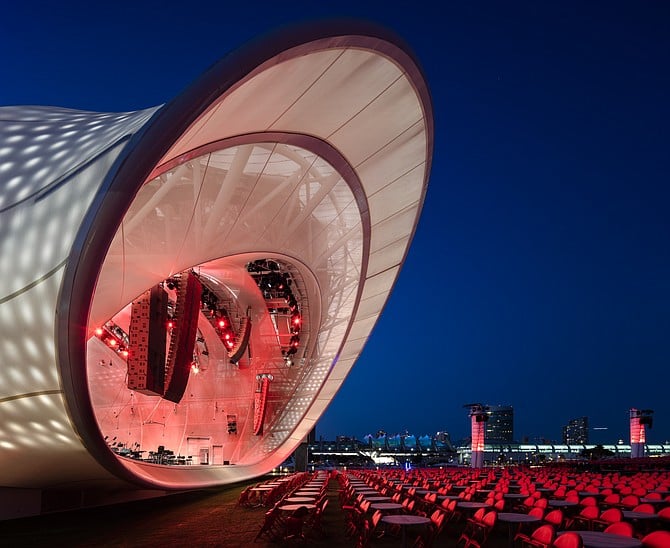 Facebook
Facebook
 X
X
 Instagram
Instagram
 TikTok
TikTok
 Youtube
Youtube

The San Diego Symphony concert on Friday, November 11, at The Rady Shell at Jacobs Park, featured a boat horn. For whatever reason, a boat was crisscrossing the harbor blowing its horn at very regular intervals. As majestic as the concert was, this wandering interruption is what almost everyone will remember.
Will we remember the U.S. premiere of a new piece entitled Time Three Movements for Orchestra by Thomas Larcher? We might since the boat horn wasn’t quite in full effect during this part of the performance. I will remember it because I found myself immersed in classical music in the middle movement. At that point in the composition, Larcher wasn’t hitting us in the face with the fact that this is new music.
I must admit it was a moment of revelation. I realized that the vast majority of new compositions are constantly reminding the audience they are modern. Modern, modern, modern. How refreshing to hear, at least for a few minutes, a new piece that wasn’t completely obsessed with its own modernity. Bravo Larcher.
Will we remember Emanuel Ax performing Beethoven’s Piano Concerto No. 2? We will because the whimsical Ax matched the pitch of the boat horn on the piano between the first and second movement and observed that we were “in the wrong key.”
All good-natured quips aside, the performance was stellar. Beethoven’s second concerto is an interesting piece because the orchestra sounds like Mozart while the piano part sounds like Beethoven. Ax made Beethoven’s piano part live and breathe with pure musicality.
I wasn’t that familiar with Dimitri Shostakovich’s Symphony No. 12 so I gave it a listen, on YouTube, before the concert and I wasn’t impressed. I wasn’t feeling the sardonic fury that informs Shostakovich’s most significant works.
However, about five minutes into the performance I was thoroughly impressed and immersed in a titanic soundscape that defied the limitations of the symphonic repertoire. Shostakovich can whip the orchestra up into a storm with the best of them and conductor Rafael Payare rode this storm as the lord of thunder.
I feel it necessary to mention the well-executed trombone solo performed by principal trombonist Kyle Covington. I only bring it up because it was easily the most expansive trombone solo I’ve ever heard and Covington had it covered.
Unfortunately, the boat horn rode out the storm and continued its inane odyssey throughout the performance. On the fortunate side, Shostakovich concluded his symphony with all the sound an orchestra can possibly muster. At this point, the boat horn bent the knee to the Shostakovich, the symphonic king. Yet as the music concluded and the audience dispersed the horn played on.


The San Diego Symphony concert on Friday, November 11, at The Rady Shell at Jacobs Park, featured a boat horn. For whatever reason, a boat was crisscrossing the harbor blowing its horn at very regular intervals. As majestic as the concert was, this wandering interruption is what almost everyone will remember.
Will we remember the U.S. premiere of a new piece entitled Time Three Movements for Orchestra by Thomas Larcher? We might since the boat horn wasn’t quite in full effect during this part of the performance. I will remember it because I found myself immersed in classical music in the middle movement. At that point in the composition, Larcher wasn’t hitting us in the face with the fact that this is new music.
I must admit it was a moment of revelation. I realized that the vast majority of new compositions are constantly reminding the audience they are modern. Modern, modern, modern. How refreshing to hear, at least for a few minutes, a new piece that wasn’t completely obsessed with its own modernity. Bravo Larcher.
Will we remember Emanuel Ax performing Beethoven’s Piano Concerto No. 2? We will because the whimsical Ax matched the pitch of the boat horn on the piano between the first and second movement and observed that we were “in the wrong key.”
All good-natured quips aside, the performance was stellar. Beethoven’s second concerto is an interesting piece because the orchestra sounds like Mozart while the piano part sounds like Beethoven. Ax made Beethoven’s piano part live and breathe with pure musicality.
I wasn’t that familiar with Dimitri Shostakovich’s Symphony No. 12 so I gave it a listen, on YouTube, before the concert and I wasn’t impressed. I wasn’t feeling the sardonic fury that informs Shostakovich’s most significant works.
However, about five minutes into the performance I was thoroughly impressed and immersed in a titanic soundscape that defied the limitations of the symphonic repertoire. Shostakovich can whip the orchestra up into a storm with the best of them and conductor Rafael Payare rode this storm as the lord of thunder.
I feel it necessary to mention the well-executed trombone solo performed by principal trombonist Kyle Covington. I only bring it up because it was easily the most expansive trombone solo I’ve ever heard and Covington had it covered.
Unfortunately, the boat horn rode out the storm and continued its inane odyssey throughout the performance. On the fortunate side, Shostakovich concluded his symphony with all the sound an orchestra can possibly muster. At this point, the boat horn bent the knee to the Shostakovich, the symphonic king. Yet as the music concluded and the audience dispersed the horn played on.
Comments